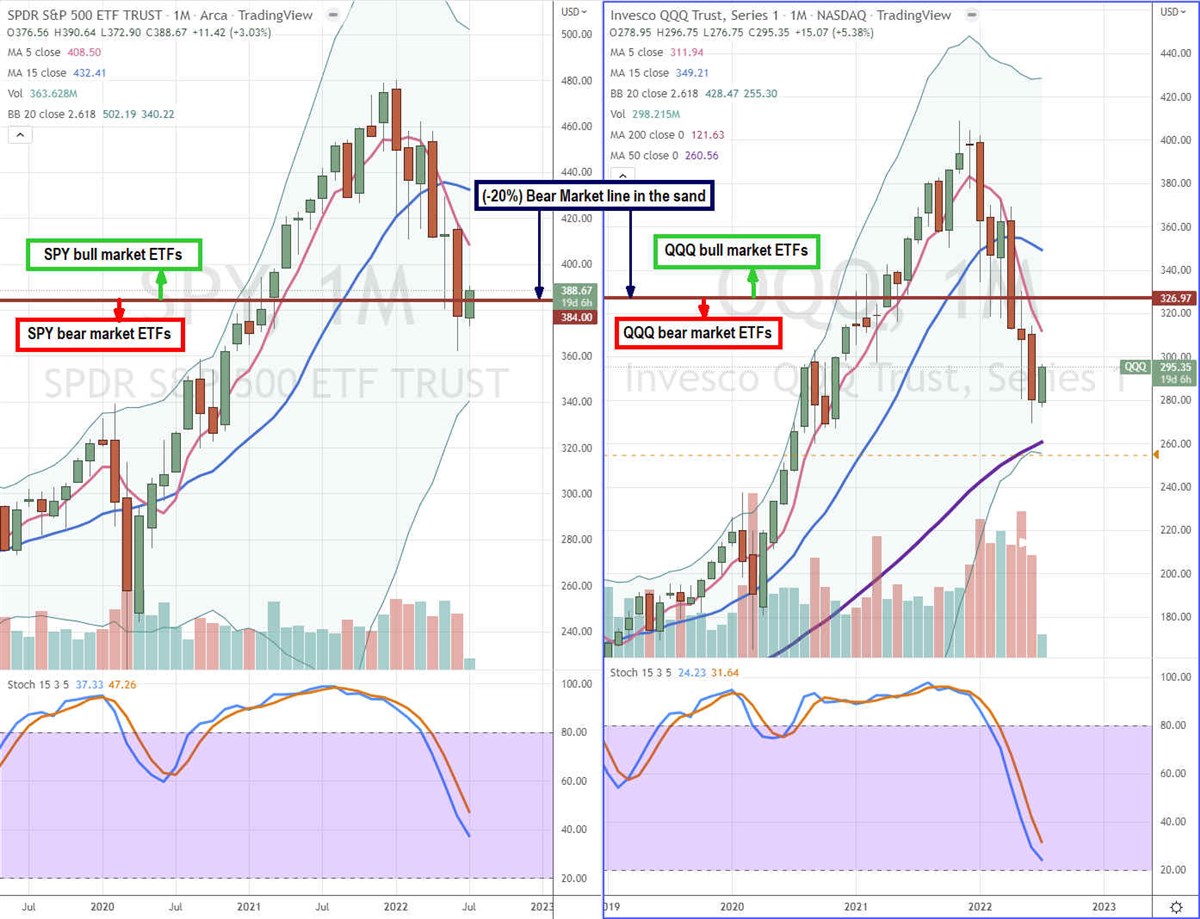 The dreaded bear market implies an economic recession led by a falling stock market. During sharp bear market sell-offs, it appears nothing is spared as panic takes over and the proverbial baby gets thrown out with the bath water. The best gauge of a bear market is to use the benchmark indices like the S&P 500 or the Nasdaq 100 (NYSEARCA: QQQ) when they trip the (-20%) pullback off the highs for longer than 60-days. While all sectors will get punished in a bear market, some sectors will take less pain than others. Therefore it’s important be aware of the sectors and which ones historically perform better in both bull and bear markets. From there, it’s a matter of applying the right allocations to the applicable sectors so your portfolio can outperform in a bear market.
The dreaded bear market implies an economic recession led by a falling stock market. During sharp bear market sell-offs, it appears nothing is spared as panic takes over and the proverbial baby gets thrown out with the bath water. The best gauge of a bear market is to use the benchmark indices like the S&P 500 or the Nasdaq 100 (NYSEARCA: QQQ) when they trip the (-20%) pullback off the highs for longer than 60-days. While all sectors will get punished in a bear market, some sectors will take less pain than others. Therefore it’s important be aware of the sectors and which ones historically perform better in both bull and bear markets. From there, it’s a matter of applying the right allocations to the applicable sectors so your portfolio can outperform in a bear market.Know Your S&P 500 Sectors
It’s important to understand that while the overall market may sell-off in a bear market, they don’t tend to sell-off equally. The S&P 500 index is comprised of 11 sectors: Information Technology, Health Care, Financials, Consumer Discretionary, Communication Services, Industrials, Consumer Staples, Energy, Utilities, Real Estate, and Materials. The market capitalization differs among the sectors as well as the relative strength and weakness during the different market and economic climates. The S&P 500 index can be tracked and traded utilizing the SPDR S&P 500 ETF Trust (NYSEARCA: SPY). While the SPY has 11 sectors, the heavier weighted sectors make a greater impact on the overall index. The current top five heaviest weightings are Information Technology 27.21%, Health Care 14.94%, Consumer Discretionary 10.90%, Financials 10.75%, and Communication Services 9.10%. You can delve deeper and see the top holdings which represent the underlying stocks that have the heaviest weighting in the index like Apple (NASDAQ: AAPL) at 6.84% , Microsoft (NASDAQ: MSFT) 6.10%, and Amazon (NASDAQ: AMZN) at 3.09%. There are liquid exchange-traded-funds (ETFs) available for each sector that are readily tradeable just like stocks. Using these ETFs is the way to quickly adjust your portfolio as needed.
Strong Bull Market Sectors
While bull markets tend to lift all sectors. Not all sectors are equal. These strongest sectors during an economic expansion and bull market tend to be Information Technology (NYSEARCA: XLK) (-24% year-to-date), Consumer Discretionary (NYSEARCA: XLY) (-30% YTD), Financials (NYSEARCA: XLF) (-19%), and Industrials (NYSEARCA: XLI) (-16%). Consumers are spending more money on discretionary items and technology as well as creating more wealth with their brokers and using their credit cards boosting banks. You can see the year-to-date (YTD) performances on these ETFs illustrating how weak they are in the current bear market.
Strong Bear Market Sectors
In recessions and bear markets, consumers tend to rein in their spending to just the necessities like essential grocery items, health care, and paying utility bills. The strongest (or least weakest) sectors in a bear market tend to be Consumer Staples (NYSEARCA: XLP) (-5.4%), Utilities (NYSEARCA: XLU) (-1.5%), Healthcare (NYSEARCA: XLV) (-6%) and Energy (NYSEARCA: XLE) +24% YTD. You can see the YTD performance on these defensive ETFs and how much better they are weathering the 2022 bear market compared to the bull market ETFs. Energy might be an anomaly as it has been outperforming every sector, therefore it’s important not to allocate too much into that sector as a reversion is inevitable.

Rotating Around Sector ETFs
Bear markets are a time for defense and risk-off. It’s a matter of who loses less in a bear market as opposed to who makes more in a bull market. As evidenced by underlying performance of the aforementioned ETFs, it’s prudent to consider adding exposure to the strong bear market sector ETFs to hedge or offset your long positions in a portfolio. As the market continues to sell-off, it would be prudent to add more of the strong bear market ETFs as protection. When the market turns around, you can start to trim the exposure to strong bear market ETFs while raising exposure to the strong bull market ETFs. Each of the ETFs also list their top holdings, so its possible to rotate the actual underlying stocks for the more active and risk-tolerant seasoned investors.
